If you want to run away from a bustling life, it’s maybe a good idea to visit the old villages in Hanoi, which are several hundred years old. Here you will enjoy the peaceful space and discover the Vietnam’s traditional architecture dating back to the 1900s.
Duong Lam old village
One of the most famous old villages in Hanoi that we should mention is Duong Lam ancient village. It is located 44 km west of the center of Hanoi, in Son Tay town. This place is also known as “the land of two kings” because it was the birthplace of Phung Hung, a military leader who briefly reigned over Vietnam during the 8th century and Ngo Quyen, a Vietnamese king of Ngo dynasty who ruled from 939 to 944. He defeated the Southern Chinese kingdom at the Battle of Bach Dang River and ended 1,000 years of Chinese domination.
Many houses in the village are over 300 years old but well preserved. Here you can enjoy the ancient, serene space that is totally different in compared with bustling city centre. With the moss-covered house lines and old roads.
In the past Duong Lam included 9 villages belonging to Cam Gia Thinh district, Phuc Tho district and Son Tay town. Among these 5 villages of Mong Phu, Dong Sang, Cam Thinh, Doai Giap and Cam Lam located next to each others. These villages are similar in customs, practices and beliefs that have not changed for thousand years.
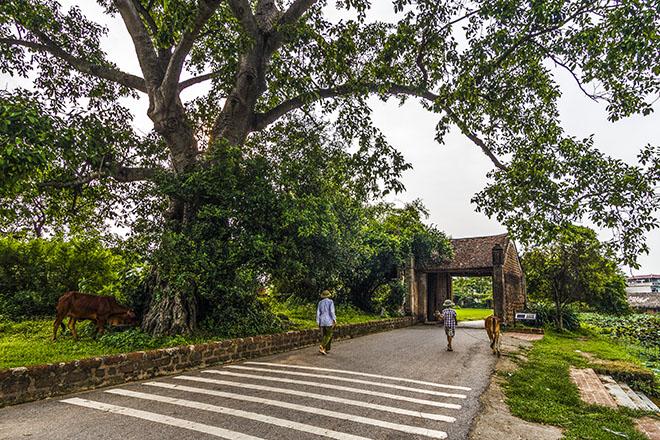
Duong Lam village’s gate
Tourists can visit Duong Lam ancient village at any time of the year. But if you come here in the September, it maybe rice-harvesting season and you will see more straw-covered village roads with gorgeously golden yellow colour. This might catch your eyes immediately, allowing you to take pictures and enjoy the fragrant smell of the rice.
Sighseeing
– Mrs. Dien’s old house
This traditional house is 200 years old, with 3 rooms in the style of the old Northern architecture. The altar is placed in the middle facing the door. the yard is the area to place the flowers or the old wine jars. This is a very typical structure of Northern Vietnam houses.
– Communal house in Mong Phu village
The communal house was built 380 years ago, 1800 square metres wide. It simulates the architecture of stilt houses with wooden floors on the ground. Inside house there are many outstanding diaphragm hanging. All of which represent many unique architectural and cultural values.
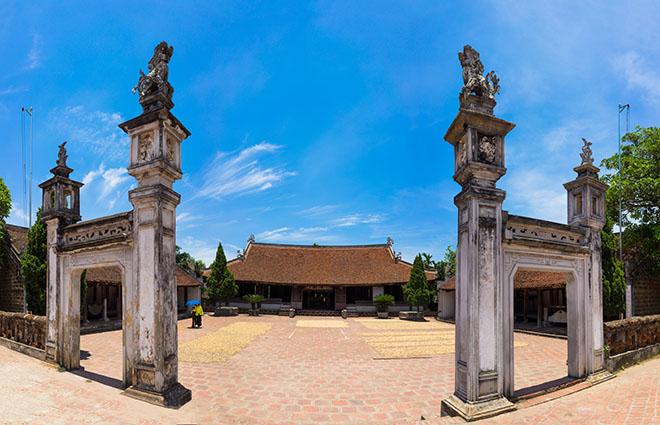
– Mr. Hung’s house
This is considered to be the oldest house in Mong Phu village, which was built since 1649. The house is structured in the style of 5 compartments, the 3 compartments in the middle are the place to worship ancestors and next to the decoration is the settee used to serve the guests and the next 2 rooms are used as rooms for sleeping.
Until now the house has been preserved almost intact the quintessence of Vietnamese architectural art. Visitors can get inside and see almost every details of the house, and on the outside the yard are gardens, flowers, and jars of wine which create a very peaceful setting.
Duong Lam specialties
Duong Lam village is famous for “che lam” – a kind of candy. “Che lam” is a combination of soft taste of glutinous rice, the fleshy taste of peanuts, the spiciness of ginger, the sweetness of molasses. Piece of blue tea is light brown, there are white flowers created by peanuts There are also famous peanuts, sesame candies, or traditional dumplings. The taste is very fragrant and typical.
Another Duong Lam speciality is “tuong gao” (rice sauce). This sauce is used to dip tofu to, fish, spinach, sweet potato or to stew meat.
Cu Da village
Cu Da village is located 20 kilometers in the west of Hanoi and belongs to Cu Khe commune, Thanh Oai district, Hanoi. It is one of the most famous old villages in Hanoi.
Cu Da ancient village is a place for those who love to learn about architecture. Or want to learn about Vietnamese history, traditional craft villages. Or simply come here to have time of relaxation. This might be a perfect place for the soul to enter a peaceful setting, feeling like time is standing still with attractively old walls faded by time passing by.
The whole village sits on the banks of the Nhue River. The convenient location for trade has brought prosperity and wealth to the village. Therefore, it is easy to understand that the most developed period of the village was the late 19th century and early 20th century when the wet rice industry still grew strongly.
Not only have the three-compartment or five-compartment houses like other villages, but the ancient village of Cu Da also has French-style houses built hundreds of years ago. The village still has old trees, communal houses, pagodas, village gates, old houses, all of which make visitors feel like going back in time.
The structure of the village has a shape of fish bones. From the big village road radiated dozens of small alleys and led into houses. In the village, most of the houses are Western style, or a combination of Eastern and Western styles.
Cu Da specialities
Mien Cu Da ( Cu Da’s bean thread noodle)
Cu Da’s bean thread noodle is famous for its delicious, chewy and characteristic aroma of arrowroot powder that is hard to get anywhere. If you come here in the morning, visitors will see the bustling scenery of the people here. They carry the vermicelli spreaders on the side of the road with wooden vermicelli, and brought the vermicelli to the sun.

Tuong Cu Da (Cu Da’s rice sauce)
Tuong Cu Da is made from four main ingredients: soybean, sticky rice, water and white salt. The craft of making soy sauce in Cu Da has been around for a long time, something that has a unique and attractive scent.
Uoc Le village
Uoc Le Village is located in Tan Uoc Commune, Thanh Oai District, which is about 30 km southwest of Hanoi. This place is extremely famous for making pork sausage (“giò chả” in Vietnamese), one of the most delicious Vietnam foods.
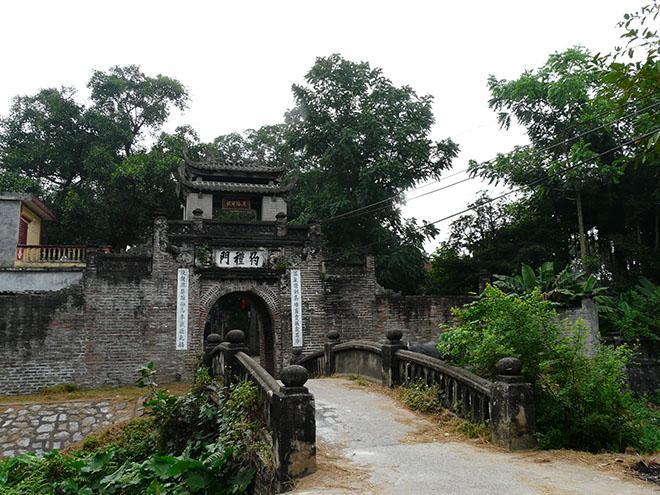
Uoc Le village’s gate
Mr. Dang Dinh Dau, 75 years old, who takes care of the village’s house every day, said that the communal house was built from the Mac dynasty and is still preserved carefully in terms of architecture and landscape. There are many diaphragm, sentences, crossbar, and meticulously carved rafters inside the house.
Every year, on the 12th of the 8th month of lunar calendar is a village holiday or on the full moon day of January, the people of Uoc Le gather for village’s celebration, pagoda ceremony, communal house ceremony. On these occasions, the elderly in village will tell about the ancient history, stories about the communal house for hundreds of years.
The Old Gate was built during the Mac Dynasty. It is one of the most beautiful village gates remaining until now.
Coming here, you can enjoy the peaceful and quiet village with lush green bamboos, straight areca trees and variegated walls of time. Traces of the past are on each stone, each mossy wall in the roof of the house, the well and the dome of the market. Visitors visiting Uoc Le will learn about the profession of making pork sausage here.
Luckily, despite of urbanization and modernization process, Uoc Le village has not been much impacted. The village still keep its tradition of making sausage.
Cuu village
Another interesting place among Top 5 old villages in Hanoi is Cuu Village. It is located in Van Tu commune, Phu Xuyen district, Hanoi.
This hold village is located on the banks of the Nhue River. The river has witnessed changes in geography and time. About 500 years ago this area was just an empty land on river bank. Then people came, gradually settled down here and found the village.
Nowadays, the village still have a few small architectural heritage lying next to modern houses. They are a mixture between traditional Vietnam’s architecture and French building style. The construction process of these houses took place in the years from 1920 to 1945. Because The French conquest of Vietnam during this time so it’s easy to understand why western architecture has such a huge influence. Over time, moss-covered mansions are gradually degraded. Unfortunately commune authorities don’t have any conservation plan for ancient houses.
In addition to visiting the old village, you can stroll around the banks of the Nhue River nearby and enjoy the view of peaceful rural landscape.
Dong Ngac Village
The village is located near the center of Hanoi capital, on Red River bank. It was built over 400 years ago. But many old architectures are well preserved and exist until now. Dong Ngac village is home of many talents and mandarins under Le, Mac, Nguyen dynasties.
The village has nearly 100 ancient houses in different ages. Some were built in 1605, over 400 years ago, quite sophisticatedly, with many valuable wooden columns.
Dong Ngac village has a mixture of traditional vietnamese architectures and french colonial buildings. For example the primary school near the communal house with small yellow pavilions. However, the walls and roof of this school are carved with dragon and lotus flowers images, which are symbol of vietnamese culture.
People usually describe Dong Ngac village as the “old village in the city”. It has both of mordern and old features. Many houses were built as mordern big villas but still keep an old house beside.
In addition to the communal house, the village also has a very beautiful Tu Khanh pagoda that you should visit.
People here are mostly very hospitable. You can visit any house and feel free to talk with people. They may invite you to drink a cup of tea or even have meal with them.
Small tips
- Walking or cycling are the best ways to explore these villages because you can go to every corner of the village easily.
- If you want to have lunch or stay overnight in the village, you should find the contact first because these families only prepare meals and rooms for you when you order.
- By strolling on the streets of old villages in Hanoi in the late afternoon, you will have a chance to enjoy the beautiful sunset.
These places are ideal for those who want to escape from the noisy urban area and find the peace. For tourists by visiting old villages in Hanoi they can learn more about local daily life as well as have an unique experiences.
A wanderlust who is into photography and has special interest in chasing clouds and admiring the sky. Hoping that someday I will be able to see the sky from every part of the world. Alida
Alida



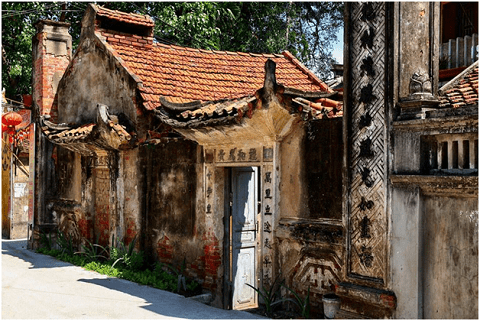
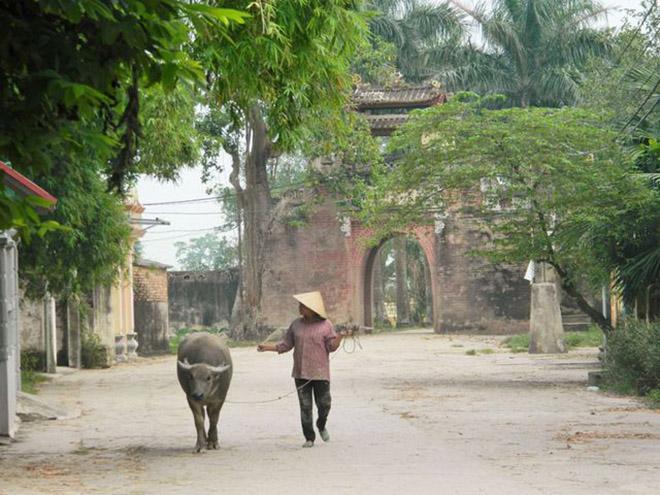
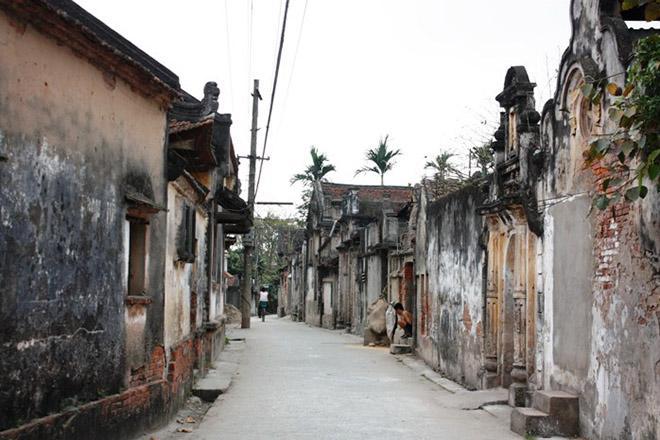

Comments